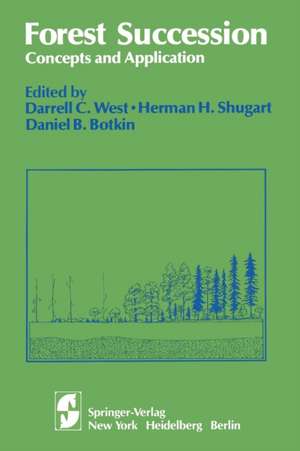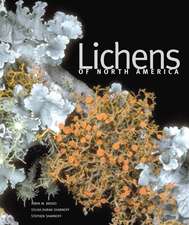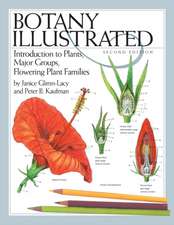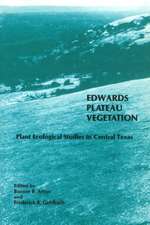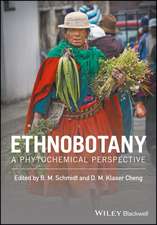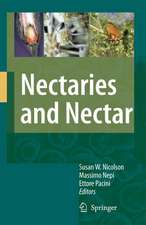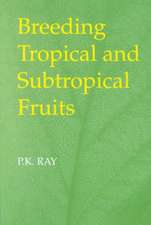Forest Succession: Concepts and Application: Springer Advanced Texts in Life Sciences
Editat de D. C. West, H. H. Shugart, D. F. Botkinen Limba Engleză Paperback – 9 noi 2011
Preț: 585.69 lei
Preț vechi: 689.05 lei
-15% Nou
Puncte Express: 879
Preț estimativ în valută:
112.09€ • 116.77$ • 93.19£
112.09€ • 116.77$ • 93.19£
Carte tipărită la comandă
Livrare economică 11-25 februarie 25
Preluare comenzi: 021 569.72.76
Specificații
ISBN-13: 9781461259527
ISBN-10: 1461259525
Pagini: 536
Ilustrații: 517 p.
Dimensiuni: 155 x 235 x 28 mm
Greutate: 0.74 kg
Ediția:Softcover reprint of the original 1st ed. 1981
Editura: Springer
Colecția Springer
Seria Springer Advanced Texts in Life Sciences
Locul publicării:New York, NY, United States
ISBN-10: 1461259525
Pagini: 536
Ilustrații: 517 p.
Dimensiuni: 155 x 235 x 28 mm
Greutate: 0.74 kg
Ediția:Softcover reprint of the original 1st ed. 1981
Editura: Springer
Colecția Springer
Seria Springer Advanced Texts in Life Sciences
Locul publicării:New York, NY, United States
Public țintă
GraduateCuprins
1 Introduction.- 2 Concepts, Theory, and Models of Forest Succession.- Synthesis and Summarization.- 3 Succession and Ecological Theory.- Ecosystem Succession.- Ecosystem Evolution.- Reduction and Emergence.- Discussion and Questions.- 4 Some Causes of Variety in Patterns of Secondary Succession.- Spatial Pattern of Recruitment and Succession.- Succession as a Tree-by-Tree Replacement Process.- When Is Secondary Succession Convergent?.- Succession as the Differential Expression of Life Histories.- 5 Causality and Succession.- Background to the Model.- Verification.- Results of the Verification: Individual Tree Growth.- Implications for Analysis of Causality in Succession.- 6 The Role of Disturbance in the Gap Dynamics of a Montane Rain Forest: An Application of a Tropical Forest Succession Model.- Description of the FORICO Model.- Gap Dynamics and the Role of Disturbance.- Models and the Study of Forest Disturbance.- 7 Patterns and Dynamics of Forests: An Application of Simulation Models.- Model Description.- Model Testing.- Patterns of Compositional Dynamics Simulated by the Four Models.- Structural Similarities in Ecosystem Dynamics.- Compositional Dissimilarities in Ecosystem Dynamics.- Species Roles in Ecosystem Dynamics.- Conclusions.- 8 Long-Term Forest Dynamics.- Methods of Study.- Implications of Results.- Conclusions.- 9 Plant Succession and Soil Development in Coastal Sand Dunes of Subtropical Eastern Australia.- The Sand-Dune Systems of the Subtropical Coast.- Present and Past Climates.- Relationships between Soils, Nutrients, and Vegetation.- Long-Term Forest Succession.- 10 Quaternary History and the Stability of Forest Communities.- Pollen as a Record of Geographical Distribution of Trees.- Forest Communities at the Time of the Last Glacial Maximum.- Northward Migrations of Boreal Trees.- Migrations of Species from the Temperate Deciduous Forest.- Discussion.- 11 Simulating the Role of Climate Change and Species Immigration in Forest Succession.- Parameters for the Model.- Comparison of Model Results and the Pollen Record.- Vegetation Migration and Development.- Conclusions.- 12 Patterns of Succession in Different Forest Ecosystems.- Boreal Forest.- Coniferous Forest.- Tropical Forest.- Discussion.- Conclusions.- 13 Forest Succession in Relation to Nutrient Cycling in the Boreal Forest of Alaska.- Summary of Succession.- Floodplain Succession.- Upland White Spruce Succession.- Upland Black Spruce Succession.- Nutrient Cycling and Succession.- Conclusions.- 14 Aspects of Succession in the Coniferous Forests of the Pacific Northwest.- Regional Setting.- General Features of the Forests.- Scale in the Pacific Northwest.- Revised Concepts about Succession in Pseudotsuga Forests.- Role of Woody Debris in Forest Succession.- Long-Lived Seral Species in Succession Modeling.- Conclusions.- 15 Secondary Forest Succession on the North Carolina Piedmont.- Past Studies on the North Carolina Piedmont.- Population Biology of Pines.- Patterns of Hardwood Establishment.- Vegetation-Environment Relations.- Conclusions.- 16 Successional Studies of a Rain Forest in Mexico.- Regeneration in a Tropical Forest.- Cicatrization of the Rain Forest.- The Role of Pioneer Species in Regeneration.- Regeneration within the Rain Forest.- Conclusions.- 17 Process Studies in Succession.- Nutrient Cycling in Succession.- Disturbance Regimes.- Disturbance and Process Studies.- 18 Successional Processes: Comparisons among Biomes with Special Reference to Probable Roles of and Influences on Animals.- Justification of the Matrix Approach.- Comparison of Successional Processes in Various Biomes: Plants.- Animals and Succession: General.- Summary.- 19 Canopy-Understory Interaction and the Internal Dynamics of Mature Hardwood and Hemlock-Hardwood Forests.- Introduction: Stability and Perceptual Scale.- Canopy-Understory Interaction and the Microsite Mosaic.- Beech-Maple Reciprocal Replacement.- Interactions among Several Species: The Hemlock-Northern Hardwood Forests.- Summary and Conclusion.- 20 Changes in Biomass and Production During Secondary Forest Succession.- Theories and Published Data.- Case Studies.- Conclusions.- 21 Above-Ground Biomass Accumulation and Net Primary Production During the First 70 Years of Succession in Populus grandidentata Stands on Poor Sites in Northern Lower Michigan.- Origin of the Aspen Forest.- Site Description and Stand Sampling.- Biomass Accumulation and Net Production.- Discussion.- 22 Below-Ground Processes in Forest Succession.- Below-Ground Ecosystem Components and Processes.- Vegetative Succession in Pacific Northwest Forests.- Root and Mycorrhizal Dynamics in Forest Succession.- Dynamics of Below-Ground Nutrients and Soil Organic Matter Interactions of Below-Ground Ecosystem Components.- An Integrated Example.- 23 Fire and Succession in the Conifer Forests of Northern North America.- Fire Regimes and Fire Cycles in Northern Conifer Forests.- Organic Matter Accumulation, Permafrost, and Paludiflcation.- Fire Characteristics and Ecological Effects.- Plant Strategies for Coping with Fire.- Vegetation Change Following Fire.- Is Lightning-Caused Fire Random or Time-Dependent?.- Fire Patterning of Vegetation Mosaics.- Implications for Succession Theory.- 24 Vegetation Change in Chaparral and Desert Communities in San Diego County, California.- The Regional Setting.- Vegetation Change in Cupressus forbesii Dominated Chaparral in San Diego County.- Vegetation Change in Larrea-Ambrosia Desert.- Discussion.- 25 Is Succession a Viable Concept in African Savanna Ecosystems?.- Determinants of Savannas.- Dynamics of Savannas.- Conclusions.- References.
